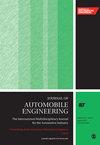教练车正面碰撞中的乘员安全与伤害:文献综述
IF 1.5
4区 工程技术
Q3 ENGINEERING, MECHANICAL
Proceedings of the Institution of Mechanical Engineers Part D-Journal of Automobile Engineering
Pub Date : 2024-06-20
DOI:10.1177/09544070241257988
引用次数: 0
摘要
客车正面碰撞造成的伤亡人数占交通事故伤亡总人数的一半以上,因此对客车正面碰撞的研究非常重要。本文献综述涉及法规、伤害标准和影响乘员伤害的因素,主要参考了有关座椅稳定性和乘员安全的国家标准。现有法规非常重要,因为它们强调了乘员头部、颈部、胸部和下肢的伤害标准。现有法规之外的伤害标准也得到了强调,特别是需要包括头部的线性加速度和角加速度。此外,客车内部结构中的许多因素都会影响伤害的严重程度。在事故中,使用不同的约束系统和改变座椅参数会对乘员的不同肢体产生不同的影响。研究表明,三点式安全带具有优势,可以保护乘员(包括成人和儿童)的头部和颈部。同时,适当的座椅间距、座椅倾斜度和其他座椅相关参数也会影响乘员头部和颈部的伤害。例如,当座椅倾斜度在 105° 至 115° 之间时,乘员头部受伤的风险较高,而当座椅倾斜度为 95° 时,乘员颈部受伤的风险较高。未来的研究应评估乘员安全中较少涉及的领域,如驾驶员和副驾驶员的安全。本综述强调了根据当前研究成果更新和加强监管要求以降低乘员受伤风险的迫切需要。本文章由计算机程序翻译,如有差异,请以英文原文为准。
Occupant safety and injuries in coach frontal collision: a literature review
Frontal collisions of coaches contribute to more than half of the total number of casualties in traffic accidents, making it important to study frontal collisions of coaches. This literature review covers regulations, injury criteria, and factors influencing occupant injury, primarily referenced national standards on seat stability, and occupant safety. Existing regulations such as these are important because they highlight the injury criteria for the head, neck, chest and lower limbs of occupants. Injury criteria outside of the existing regulations are also highlighted, particularly the need to include both linear and angular accelerations of the head. In addition, numerous factors within the interior structure of a coach can impact injury severities. The use of different restraint systems and alterations in seat parameters can have varying effects on different limbs of the occupant during accidents. The researches show that three-point seat belts are advantageous and can protect occupants’ heads and necks, both adults and children. At the same time, proper seat spacing, seat inclination and other seat-related parameters also influence the injuries to the occupant’s head and neck. For example, occupant head injury risk is high when the seat inclination is between 105° and 115°, and occupant neck risk is high when the seat inclination is 95°. Future studies should evaluate the less-covered areas of occupant safety such as the safety of driver and co-driver. This review highlighted the critical need to update and enhance regulatory requirements based on current research findings to reduce the risk of occupant injury.
求助全文
通过发布文献求助,成功后即可免费获取论文全文。
去求助
来源期刊

CiteScore
4.40
自引率
17.60%
发文量
263
审稿时长
3.5 months
期刊介绍:
The Journal of Automobile Engineering is an established, high quality multi-disciplinary journal which publishes the very best peer-reviewed science and engineering in the field.
 求助内容:
求助内容: 应助结果提醒方式:
应助结果提醒方式:


